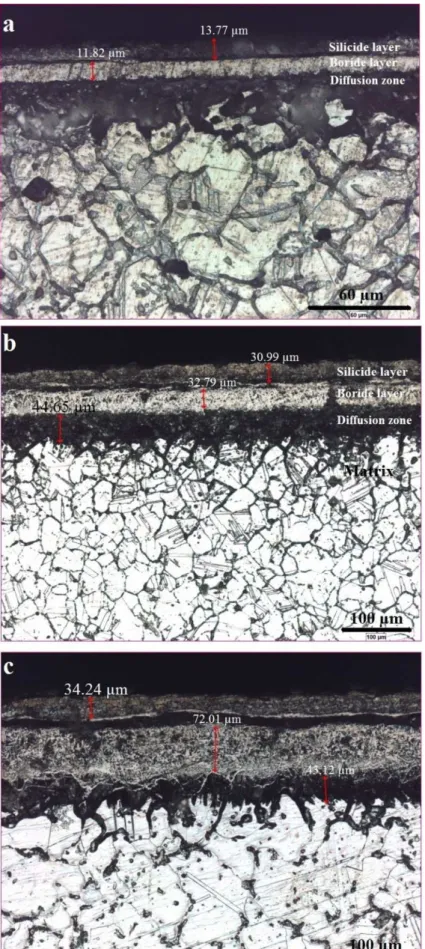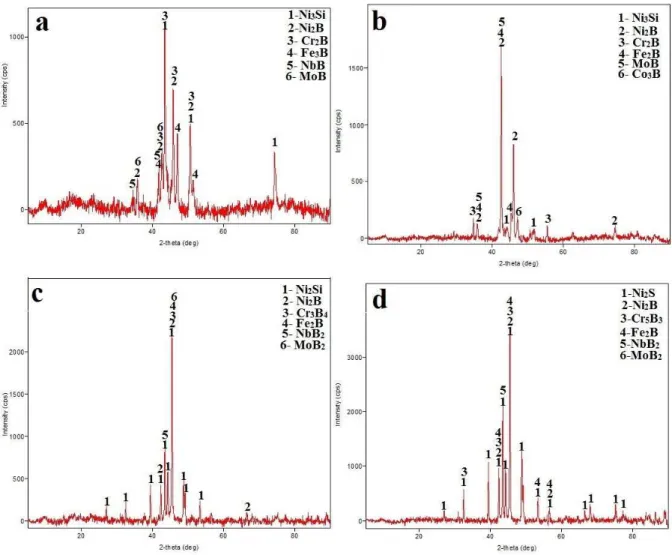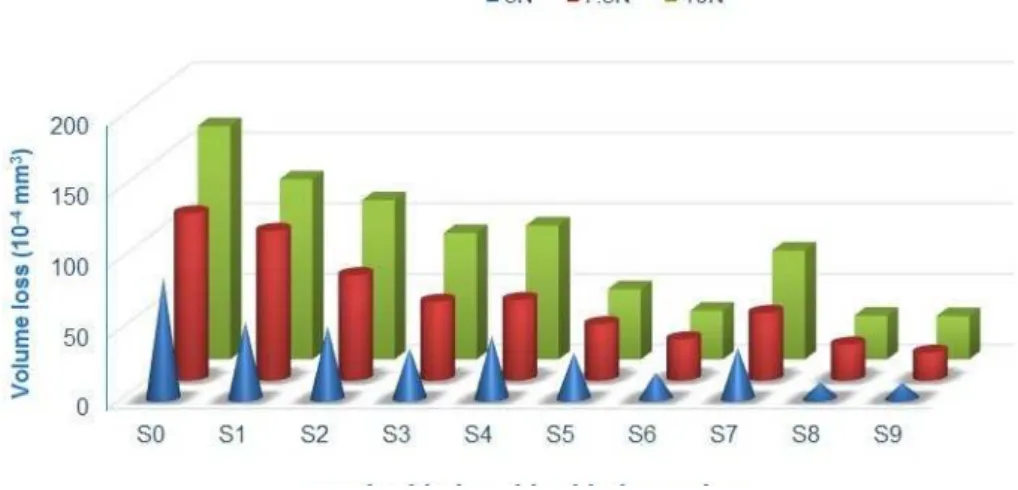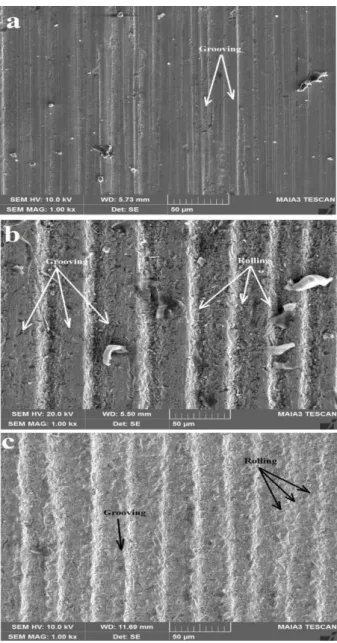ISSN 1517-7076 artigo e11829, 2017
Corresponding Author: Ali Gunen Received on: 15/06/2016 Accepted on: 13/04/2017
10.1590/S1517-707620170002.0161
Microstructure and Mechanical Properties
of Borided Inconel 625 Superalloy
Ali Gunen1, Erdogan Kanca2
1Metallurgical and Materials Engineering, Technology Faculty, Iskenderun Technical University,31200 Hatay, Turkey e-mail: ali.gunen@iste.edu.tr , aligunen2013@gmail.com
2
Mechanical Engineering, Mechanical Engineering Faculty, Iskenderun Technical University,31200 Hatay, Turkey e-mail: erdogan.kanca@iste.edu.tr
ABSTRACT
The Ni- based superalloy Inconel 625 is extensively used owing to its high strength, excellent fabricability, good weldability and outstanding resistance to high temperature corrosion against aggressive environments. However, despite its unique properties and extensive use, its wear resistance is in some cases unsatisfactory. In this study, Inconel 625 was subjected to boriding treatments at different temperature and different durations. Microstructural characterization was made by conventional methods (scanning electron microscopy, optic microscopy, X-ray diffraction analysis) and mechanical characterization was made by microhardness and micro-abrasion wear test. Micro-abrasion wear tests were conducted against a AISI 52100 steel under 5, 7.5 and 10 N load in a 25 wt.% SiC slurry at room temperature. Microstructural results revealed that multi-phase boride layer (nickel boride, chrome boride and iron boride) and silicide layer were formed. The hardness and thickness of the boride layers were found to be 1175–2432 HV0.1 and, 6.61 – 92.03
m, respectively. Depending on the boriding temperature and time. In spite of silicide layer formation the wear resistance of borided Inconel 625 alloy increased up to 8 times thanks to the increase in the surface hardness which was caused by boriding process. The boriding treatment caused a transition in the wear mechanism. While grooving was observed in the untreated Inconel 625 samples, mixed (grooving and rolling) and rolling type wear was predominant in the borided samples.
Keywords: Ni-based superalloy, Coating, Microstructure, Mechanical properties, Wear.
1. INTRODUCTION
Superalloys or high-performance alloys are materials that are capable of retaining their mechanical properties and surface stability even at high temperatures [1]. The first superalloys were mere modifications of austenitic stainless steels and many of the superalloy in use today were developed between the 1950 and 1970s. Toward the 1980s, super alloys gained improved mechanical properties with the addition of specific alloying elements [1, 2].
Superalloys are characterized by their inherent resistance to oxidation and corrosion, resistance to thermal creep deformation and excellent high temperature mechanical strength. Because of these properties superalloys are used in many advanced engineering applications such as turbo aircraft and superchargers turbine engines, land-based and aircraft gas turbines, rocket engines, chemical, and petroleum plants and other challenging environments [1-3].
Superalloys are based on group VIII elements and classified into three groups according to the main alloying element in their composition as that nickel, iron-nickel and cobalt-based. On the other hand the commercial classifications are Inconel, Hastelloy, Hayness alloys, Waspaloy, Rene alloys, Incoloy, MPT98T, TMS alloys and CMSX single crystal alloys [1].
surface protection against wear [4].
For this reason, many processes were developed in order to improve the tribological properties of Ni-based Inconel 625 by applying protective coatings with methods such as plasma spray coating, selective laser melting, CVD aluminide coating, nitridig, etc. However, there are some disadvantages such as poor adhesion bond between the coating layer and the substrate in thermal spray, longer processing periods in CVD coating process, formation of pores and cracks in laser melting process and relatively thin layers in nitriding even after very ong durations (6 to 40 h) indicates the necessity for new, alternative coating methods [2, 3]. On the other hand, it has been found that only a few studies related to the boriding of Ni-based superalloys [5-10]. This has triggered the current study which focuses on the boriding of the Ni-based Inconel 625 superalloy.
Boriding is a well-known thermo chemical surface modification process in which boron atoms (thanks to their relatively small atomic radius) diffuse into the matrix and form chemically bonded hard phases ( based on the chemical compositions such as FexBy, CrxBy, NixBy) with the substrate metal. In order to obtain a suited boride layer, the boriding treatment is generally applied at temperatures 700–1050 °C and for the durations differencing from 30 minutes to 12 hs [11]. Many different boron compounds can be used as boriding agents for the boriding treatment based on the selected boriding method. Boriding can be implemented by many different boriding techniques, such as pack boriding, molten salt boriding, gas boriding, paste boriding, and plasma boriding. Among these techniques pack boriding is the most commonly used technique owing to its simplicity, technology and cost-effectiveness methods [11, 12].
The characteristic features of the boride layers formed on the surface are high hardness, low coefficient of friction and high wear resistance (even at high temperature). Many studies in the literature have stated that borided materials can show much better wear resistance when compared with the nitrided, carbonitrided, carburized or hard chrome plated materials [8]. Moreover boride layers exhibit abrasion and wear resistance comparable to sintered carbides [11].
Boride coatings have a prominent place in industrial applications. Although primary boriding treatments were applied overly to ferrous alloys (Low C steels, C steels, tool steels, stainless steels, etc.) [11
-13, 18, 19] they are recently being applied to many groups of alloys such including non- ferrous metals and cermets. However the boriding of superalloys is relatively new and studies studies on this subject are limited [5-10].
Previous studies have shown that the hardness of the Ni-based superalloys can be increased up to 1500 HV [7, 8, 10]. Moreover, the friction coefficient decreases and wear resistant improves by the process [5-10]. However, there are only very few studies exist on the micro-abrasion wear behavior of Ni-based superalloys. The purpose of this study, therefore, is to investigate the micro-abrasion wear behavior of Ni-based Inconel 625 superalloys, borided at different temperature and durations, under different loads in a 25 wt.% SiC slurry..Then effect of boriding parameters on wear resistance and wear mechanisms of Ni-based superalloy are evaluated.
2. MATERIALS AND METHODS
Ni-based Inconel 625 was chosen as the substrate alloy for this study. Chemical analysis of the alloy was carried out utilizing a Thermo Jarrell Ash/Baird DV-6S 3063A spectral analyzer and given in Table 1. Prior to the boriding treatment, 40x40x5 mm rectangular samples were cut from 5-mm thick alloy sheet.. All samples were ground using 1200 grit SiC paper and then washed in distilled water and ultrasonically cleaned in acetone for 10 minutes. The samples were then packed with commercially Ekabor II powders in a stainless steel container. Boriding was performed at 800, 900 and 1200 ºC for 2, 4, and 6 h. Commercial Ekrit powders (finely ground SiC) were added as a thin layer to minimize oxidation. After boriding, the steel container was removed from the furnace and allowed to cool in open air.
Table 1: Chemical composition (wt.%) of the Inconel 625 Ni-based superalloy used in experimental studies
Ni Cr Mo Fe Nb Co Mn Si Al Ti
58 22 9.1 5 3.10 1 0.5 0.50 0.40 0.40
Metallographic studies were carried out using a Nikon MA-200 inverted metallurgical microscope equipped with Clemex Vision software. Scanning Electron Microscopy (SEM) studies were conducted using a JEOL JSM-5600 SEM equipped with Energy Dispersive Spectroscopy (EDS) capability, at 25 kV accelerating voltage. Microhardness values of boride layers were obtained by utilizing a Highwood HWMMT-X3 hardness tester using 100 g load and 15 s dwell time. Hardness measurements on silicide layers were made by using 25 g load after cracking was observed at 100 and 50 g load. The thicknesses of produced layers were determined by a Clemex digital thickness measurement instrument attached to a Nikon MA-200 optical microscope. X-ray diffraction analyses (XRD) were carried out using a computer-controlled Bruker AXS D8 Advance with Cu Kα radiation ( Cu = 0. 1540 nm) and 2θ angles ranging from 10° to λ0°.
The fixed-ball micro abrasion wear test was performed for untreated and borided samples. The ball used in this test had a diameter of 25.4 mm and was made of AISI 52100 steel. Prior to each test, surface samples and ball were ultrasonically cleaned in acetone for 5 minutes and then air dried. Silicon carbide (SiC) was used as the abrasive with an average particle size smaller than 800 mesh. The abrasive slurry was created with 25 wt.% SiC in distilled water. The rotational speed of the ball was set to 90 rpm the course of these tests, abrasive slurry was dropped as 0.2 ml in every 20 seconds. The total test time for each sample was determined as 3 minute. Each test was repeated three times. Radius wear crater determined via SEM and volume loss of the worn samples calculated by using the equation:.
� =
�. �464.�
(1)
Where, where, B is the outer diameter of the crater in mm and R is the radius of the ball used in the wear test (12.7 mm).
3. RESULTS AND DISCUSSIONS
3.1. Microstructures
Figure 1 shows the microstructure of the untreated commercial Inconel 625 alloy.
Figure 1: Microstructure of commercially Inconel 625 Ni-based superalloy.
OM micrographs of the box borided layer formed on Inconel 625 superalloy at the temperatures 800, 900 and 1000 °C for 4 h with Ekabor II powder were shown in Figure 2a-2c, respectively.
As seen from Figure 2 the borided samples consisted of three distinct layers. As stated in the previous study these layer has been ranked from to the surface inwards as silicide layer, multi-phase boride layer and diffusion zone, respectively [5-7, 8, 9]. The boride/silicide volume ratio is higher than the ratios observed in previous studies [6,7]. This situation is thought to be the result of Ar atmosphere and used Al2O3 Ekrit powder. Because silicide layer rates decreased with increasing process duration times. This can be explained in this way the oxygen, which entered to crucible during charging, is reduced with time. Thus achieving a lower silicide and a higher boride layers. The thickness of boride layer and silicide were close to each other at 2 h whereas at high duration the ratio of boride layer increased to 2-3 times (Table 2).
3.2 Microhardness and thickness of produced layers
The measured hardness and thickness values for the silicide and boride layers and the diffusion zones depending on boriding process conditions, are listed in Table 2.
Table 2: Hardness and thickness of produced layer
Named Boriding
Conditions
Silicide layer Boride layer Layer
thickness Diffusion zone (µm) Thickness (µm) Hardness
(HV0.025)
Thickness
(µm)
Hardness
(HV0.1)
S1 800 °C, 2h 7.58 556 6.61 1175 8.75
S2 800 °C, 4h 13.77 648 11.82 1204 20.18
S3 800 °C, 6h 12.52 632 22.12 1359 28.15
S4 900 °C, 2h 10.19 652 10.51 1216 13.92
S5 900 °C, 4h 30.99 930 32.79 1666 44.65
S6 900 °C, 6h 31.03 740 65.65 1787 42.78
S7 1000 °C, 2h 12.21 630 12.45 1588 20.45
S8 1000 °C, 4h 34.24 935 72.01 2154 43.12
S9 1000 °C, 6h 33.85 812 “λ2.03 2432 41.60
As shown in Table 2, the increase in boriding temperature and duration time did not only contribute to the increase in the micro-hardness values of the boride layer but also to the growth in the thickness. The
thicknesses of silicide and boride layer ranged from 7.58 to 34.24 m and 6.61 to λ2.03 m, respectively. While the hardness silicide layer ranged from 556-935 HV0.025 and boride layers ranged from 1175-2432 HV0.1 depending on boriding temperature and duration time. When compared to the literature, significantly higher hardness values and thicker boride layers were obtained [5-9]. This is attributed to formation of hard boride phases such as CrB and Ni2B [13] that are discussed in detail by XRD analyses. Also, on hardness and layer thickness of formed boride layer boriding time it seems to be a more effective parameter rather than temperature..
Considering Table 2, it can be seen silicide layer increased with increasing boriding temperature. However, silicide layer increased while boriding time increased from 2 h to 4 h whereas silicide layer decreased when boriding time increased from 4 h to 6 h. This situation shows that the O2 depleted after a certain period due to studied in Ar environment and in this way prevented the higher silicide layer formation. The hardness of the silicide layers ranged from 556 to 935 HV0.025 and consistent with the literature data [6,
8].
3.3. XRD analysis of multi-phase coating layer
XRD patterns of some of the borided samples are presented in Figure 3a-3d. A multi-phase coating layer formed depending on chemical composition of Inconel 625 superalloy and boriding agent. Ni2B phase was formed in all process conditions according to Ni-B equilibrium system. Silicide phases, which formed due to containing of SiC in Ekabor II powder, forms as Ni3Si at 800 °C and Ni2Si at 900 and 1000 °C. Cr2B, Cr3B4 and Cr5B3 phases identified in 800°C for 2 and 6 h, 900 °C for 6 h and 1000 °C for 6 h, respectively. Cr5B3 phase have effect on coating hardness by hindering the dislocation motion [14]. The highest hardness values obtained in this sample which formed Cr5B3 phase. In addition minor phases Fe3B, Fe2B, MoB, MoB2, NbB, NbB2 and Co3B were identified depending on chemical composition of Inconel 625 superalloy. This indicated that formation of phases such as CrB and Ni2B provides higher hardness in the boride layer [13]. So higher hardness values obtained according to previous study. Dinc et. al., obtained Ni4B3, Ni2Si and FeB whilw Deng et. al. FeNi, Ni2B, Ni2Si, Ni4B3, Fe2B and CrB in Inconel 718 Ni-based superalloy [7, 10].
Figure 3: XRD pattern of borided Inconel 625 a) 800 °C for 2 h b) 800 °C for 6 h c) 900 °C for 6 h and d) 1000 °C for 6h.
3.4. Micro-abrasion wear tests
Table 3: Radius of wear tack and calculated volume loss values for samples subjected to micro-abrasion wear testing.
Samples
Radius of wear track (µm) Volume loss (10-4mm³)
5N 7.5N 10N 5N 7.5N 10N
S0 12222 1323 1438 86.14 118.35 165.19
S1 1089 1287 1348 54.33 105.99 127.55
S2 1073 1179 1307 51.21 74.65 112.73
S3 979 1096 1234 35.48 55.74 89.58
S4 1034 1102 1252 44.16 56.97 94.92
S5 956 1008 1066 32.26 39.88 49.88
S6 827 932 973 18.07 29.14 34.62
S7 978 1055 1189 35.34 47.85 77.20
S8 732 901 947 11.09 25.45 31.07
S9 726 845 945 10.73 19.69 30.80
It can be seen from Table 3 that the wear track radius for the untreated samples are higher than all borided samples regardless of the boriding parameters. The radius of the wear track increased with increasing load. Correspondingly, the volume loss of the samples also increased with increasing load (Table 3 and Figure 4).
This increase can be attributed to the increased tension on the same particles as a result of increasing the load on the particles in abrasive solution. As the applied load on the particles, pinched between the sample surface and ball, increases it will give rise to a larger penetration depth for the abrasive particles into the surface. The hardness of the sample is one of the important parameters involved in this plunging process. Generally, increasing surface hardness provides more resistance to penetration. Consequently, wear due to two-body or three-body abrasion is reduced. Microstructure and macro-mechanical properties of the sample will be of importance here [15]. The particles which hold to each other in sizes of 30-40 µm due to the plastic deformation are removed off by abrasive cutting effect starting from their splat connection points, which are their weakest connections [16]. With that metal transfer takes place from the surface.
Considering the results of the wear tests, the borided samples tested under 5, 7.5 and 10 N loads showed about 8, 6 and 5 times less volume loss in comparison to their untreated counterparts, respectively. Reduction of the wear resistance ratio of borided samples with increasing force can be explained as follows. With increasing the load on the abrasive particles (SiC) give rise to fragmentation of SiC particles. So that the SiC particles have more sharp edges and act as the secondary abrasive particles. Eventually this give rise to increases in volume loss.
On the other hand, the hardness of the samples also have a great effect on the wear resistance of the samples [11, 15, 17-19]. As the best wear resistance was obtained in the highest hardness samples and wear resistance decreased in accordance with decrease in hardness (Figure 4). This supports the often observed thesis, put forward by many studies, that hardness is one of the important parameters that increase wear resistance of the materials. This can be attributed to some degree on the force that is transmitted onto the abrasive particles. The penetration depth of the abrasive particles decreases on harder surfaces and this is what leads to lower volume losses in these materials.
The relative movement of the abrasive particles between the ball and the worn sample identify the type of occurring wear mechanism in worn sample [20]. If the abrasive particles do not move on the surface of the ball a series parallel groves form on the worn surface. This called two body abrasion or grooving-type wear. On the other hand, if the abrasive particles are free to move between the ball and worn surface, three-body abrasion or rolling-type wear occurs [16, 20]. An SEM view of the Inconel 625 sample, worn at 90 rpm under a) 5 N b) 7.5 N c) 10 N in wt. 25% SiC abrasive suspensions, is shown in Figure 5.
From Figure 5 it can be seen that the predominant wear mechanism of untreated Inconel 625 was grooving at 5 N and 7.5 N load. The main difference between wear surfaces observed at 5 N and 7.5 N parameters is the width of the wear groove, which appears wider at 7.5 N (Figure 5b). However, in the sample worn under 10 N, there is evidence of grooving some regions of the surface and rolling on other regions. This is related with the increase of applied load. As applied load is the most effective parameter in the abrasion of particles on the surface of the sample due to the shear effect caused by the ball rolling down. Consequently, the increase in applied load was provide easier removing material from the surface and this was facilitated the movement of abrasive particle between the ball and worn surface. So in the form of rolling traces formed instead of groove trace. However, this is only valid in cases where the hardness of the abrasive particle higher than wearing surfaces.
Many of studies have been reported that the mechanical properties of the material has a significant effect on the type of wear [11, 15, 17-19]. SEM view of the sample with hardness 1204, 1666 and 2432 HV0.1 and worn under three different load presented in Figure 6, Figure 7 and Figure 8, respectively.
Figure 6a-6c shows a SEM image of the worn surface of the sample borided at 800 °C for 4 h. It can be seen from Figure 6a and 6b the wear mechanism of the samples were grooving in the untreated Inconel 625 alloy. But with a higher load of 10 N, in the same sample, mixed type (including roll and groove shape) wear tracks observed on boride layer (Figure 6c). This shows that increasing load can greatly influence the wear mechanism.
Figure 7a-7c shows a SEM image of the worn surface of the sample borided at 900 °C for 4 h.
Figure 7: SEM view of the sample, borided for 4 h at 900°C then worn at 90 rpm under a) 5 N b) 7.5 N c) 10 N with 25% SiC abrasive suspensions.
well as the volumetric losses indicate that the abrasive particles were not able to penetrate the hard boride layer. The highest wear resistance was obtained in the sample with highest hardness. In the other hand, when the low load (5 N) was applied, the predominant wear mechanism was also rolling even though it was still possible to see a few grooving wear track in some limited areas. When applied load increased to 7.5 N and 10 N the observed wear mechanism seemed to change completely to that of the rolling wear.
In conclusion, it can be said that both high surface hardness of borided samples and applied load were effective on changing the wear mechanism and wear resistance of Ni-based Inconel 625 superalloy. As the hardness and the applied load are important factors for plunging of abrasive particle into the surface. In addition high applied loads cause to breaking the abrasive particles, so the abrasive particles have more abrasive corner and this cause to growth in volume loss in comparison to low load.
4. CONCLUSIONS
In this study, the microstructure and mechanical properties of borided Inconel 625 Ni-based superalloys were investigated. From the obtained results, the following conclusions are drawn:
Inconel 625 Ni-based superalloy was pack borided efficiently at temperatures of 800 °C, 900 °C and 1000 °C for 2, 4 and 6 h durations.
The coating layers produced on the surface had a smooth morphology.
The layer produced consisted of four zones: These zones, moving from the outer surface to the core were marked as the silicide layer, the multi-phase boride layer, the diffusion zone and the substrate respectively.
The application of the boriding treatment under Ar atmosphere has a positive effect on reducing silicide formation especially at high duration time (6h).
Increase in boriding temperature and duration time did not only contribute to increase in micro-hardness values of the boride layer but also to its thickness
The micro-hardness of the multi-phase boride layer ranged between 1175 to 2432 HV0.1. Higher values of micro-hardness is pointed to chromium borides, such as Cr4B3 and Cr5B3.
All of the borided specimens displayed higher wear resistance in comparision with the untreated Inconel 625 superalloy.
The wear resistance of the borided samples was about 8, 6 and 5 times higher than the untreated samples under 5, 7.5 and 10 N load, respectively.
The wear resistance of the borided specimens increased with increasing surface hardness. Increase in applied load resulted in increase wear losses for all samples.
Both surface hardness and applied load were effective in changing the wear mechanism and wear resistance of the Ni-based Inconel 625 superalloy.
5. ACKNOWLEDGMENTS
This study was supported by the Mustafa Kemal University Research Council (Project Number 13911). The authors wish to thank Mustafa Kemal University Research Council for its grant contributions to this study.
6. BIBLIOGRAPHY
[1] GEDDES, B., LEON H AND HUANG X., Superalloys alloying and performance, ASM International Materials Park, Ohio, 2010.
[2] DONACIHE, M., DONACIHE, S., Superalloys A Technical Guide, 2 ed., ASM International, 2002. [3] EISELSTEIN, H.L., TILLACK, D.J., In: Loria EA, editor, Superalloy 718, 625 and various derivatives, Warrendale, PA, TMS, 1991.
[4] SPECIAL METALS CORPORATION, INCONEL and INCOLOY are trademarks of the Special Metals
Corporation group of companies, 2013.
[5] PETROVA, R.S., SUWATTANANONT, N., SAMARDZIC, V., “The effect of boronizing on metallic alloys for automotive applications”, J. Mater. Eng. Perform., v. 17, n. 3, pp. 340–345, 2008.
[6] MUHAMMAD, W., HUSSAIN, K., TAUQIR, A., et al., ‘‘Evaluation of halide-activated pack boriding
of inconel 722’’, Metallurgical and Materials Transactions A,v. 30, n. 3, pp. 670−675, 1λλλ.
[7] DINC, H., MOTELLABZADEH, A., BAYDOGAN, M., et al., “Thermochemical boriding of Inconel 718
superalloy”, Academic Journal of Science, v. 2, n. 2, 2013.
In-conel 600-alloy”, Applied Surface Science, v. 284, pp. 757– 771, 2013.
[9] MAKUCH, N., KULKA, M., ‘‘Microstructural characterization and some mechanical properties of gas-borided Inconel 600-alloy”, Applied Surface Science, v. 314, pp. 1007–1018, 2014.
[10] DENG, D., WANG, C., LIU, Q., et al., ‘‘Effect of standard heat treatment on microstructure and prope
r-ties of borided Inconel 718”, Trans. Nonferrous Met. Soc. China., v. 25, pp. 25437−25443, 2015.
[11] GUNEN, A., KANCA, E., DEMIR, M., et al., “Micro-abrasion wear behavior of fast borided steel tooth
drill bits”, Tribology Transactions, v.60, n.2, 2016.
[12] ULUTAN, M., YILDIRIM, M.M., CELIK, O.N., et al., ‘‘Tribological properties of borided AISI 4140
steel with the powder pack-boriding method”, Tribology Letters, v. 38, pp. 231-36, 2010. [13] SİNHA, A. K.,Boriding (Boronising), ASM Handbook, v. 4, pp. 437-447, 1991.
[14] LIU, S.L., ZHENG, X.P., “Microstructure and properties of AC-HVAF sprayed Ni60/WC composite coating”, J. Alloy. Compd., v. 480, pp. 254–258, 2009.
[15] HUANG, S., SUNN, D., WANG, W., et al., ‘‘Microstructures and properties of in-situ TiC particles reinforced Ni-based composite coatings prepared by plasma spray welding”, Ceramics International, v. 41, pp. 12202–12210, 2015.
[16] KURT, B., KUÇUK, Y., GOK, M.S., ‘‘Microabrasion wear behavior of VC and CrC coatings deposited by thermoreactive diffusion technique”, Tribology Transactions, v. 57, n. 2, 2014.
[17] KARAOGLANLI, A.C., CALISKAN, H., GOK, M. S., et al., ‘‘Acomparative study of the microabr a-sion wear behavior of CoNiCrAlY coatings fabricated by APS, HVOF, and CGDS techniques”, Tribology Transactions, v.57, n. 1, pp. 11-14, 2014.
[18] GUNEN, A., KUÇUK, Y., ER, Y., et al., ‘‘Effect of the powder particle size on the wear behavior of
boronized AISI 304 stainless steel’’, Material Testing, v. 57, n. 5, pp. 468-473, 2015.
[19] GUNES, I., YILDIZ, I., ‘‘Investigation of adhesion and tribological behavior of borided AISI 310 stai
n-less steel’’Materia-Rio De Janeiro, v. 21, n. 1, pp. 61-71, 2016.
[20] BATISTA, J.C.A., MATTHEWS, A., GODOY, C., ‘‘Micro abrasive wear of PVD duplex and single‐









